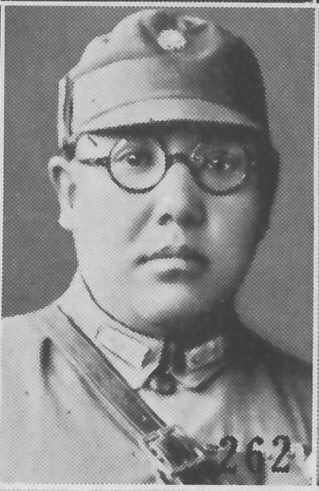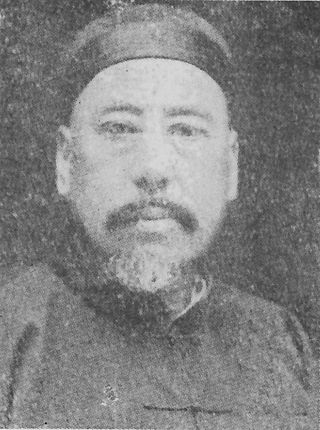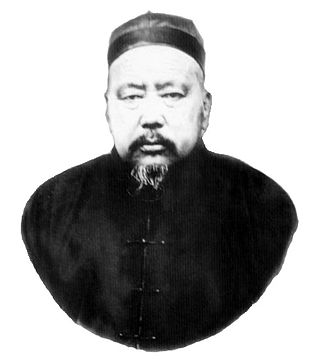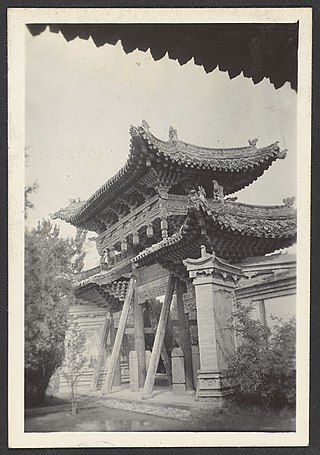
Ma Hongkui was a prominent Muslim warlord in China during the Republic of China era, ruling the province of Ningxia. His rank was lieutenant general. His courtesy name was Shao-yun (少雲). In 1950, Hongkui migrated to the United States, where he lived until he died in 1970.

Ma Bufang (1903 – 31 July 1975) (traditional Chinese: 馬步芳; simplified Chinese: 马步芳; pinyin: Mǎ Bùfāng; Wade–Giles: Ma3 Pu4-fang1, Xiao'erjing: مَا بُفَانْ) was a prominent Muslim Ma clique warlord in China during the Republic of China era, ruling the province of Qinghai. His rank was lieutenant-general.

Ma Hongbin, was a prominent Chinese Muslim warlord active mainly during the Republican era, and was part of the Ma clique. He was the acting Chairman of Gansu and Ningxia Provinces for a short period.

Ma Lin was the governor of Qinghai 1931–38 and the brother of Ma Qi. A Muslim born in 1873, Linxia County, Gansu, he mainly acceded to the posts of his brother, being general of southeastern Gansu province, as well as councillor of the Qinghai provincial government and acting head of the Construction Bureau of Qinghai province. His father was Ma Haiyan.

Ma Qi was a Chinese Muslim General in early 20th-century China.

Ma Fuxiang was a Chinese Muslim scholar and military and political figure, spanning from the Qing Dynasty through the early Republic of China. His positions illustrated the power of family, the role of religious affiliations and the interaction of Inner Asian China and the national government of China. A prominent Muslim warlord in northwest China, Ma Fuxiang originally served under Dong Fuxiang, like other Ma Clique Muslim warlords such as Ma Anliang.

Ma Buqing (1901–1977) was a prominent Ma clique warlord in China during the Republic of China era, controlling armies in the province of Qinghai.

Ma is a Chinese family name. The surname literally means "horse". As of 2006, it ranks as the 14th most common Chinese surname in mainland China and the most common surname within the Muslim minority community, specifically the Hui people, Dongxiang people and Salar people. In 2019 it was the 13th most common surname in mainland China. A 2013 study found it to be the 13th most common, shared by 17,200,000 people or 1.290% of the population, with the province with the most being Henan. It is the 52nd name on the Hundred Family Surnames poem.

During the Manchu-led Qing dynasty (1644–1912), Islam was a significant religion in Northwestern China and Yunnan. There were five major Muslim rebellions during the Qing period. The first and last rebellions were caused by sectarian infighting between rival Sufi Muslim orders.

Linxia County is a county in the Linxia Hui Autonomous Prefecture, province of Gansu, China.

Ma Anliang was a Hui born in Hezhou, Gansu, China. He became a general in the Qing dynasty army, and of the Republic of China. His father was Ma Zhan'ao, and his younger brothers were Ma Guoliang and Ma Suiliang 馬遂良. Ma was educated in Chinese and Islamic education. His Muslim name was Abdul Majid.

Ma Wanfu, also known as Hajji Guoyuan (果园哈只), was a Dongxiang Imam of Guoyuan village (果园村) in Hezhou. He studied in Mecca and founded the Ikhwan movement in 1888, also known as the "New Sect", spreading in Gansu, Ningxia and Qinghai. He opposed Sufism.
Yihewani, or Ikhwan, is an Islamic sect in China. Its adherents are called Sunnaiti. It is of the Hanafi school, one of the four major schools of Sunni Islam. It is also referred to as "new teaching" or "latest teaching". Ikhwan (Yihewani), together with Qadim (Gedimu) and Xidaotang, are the three major sects of Islam in China. The Yihewani sect was labeled as the new teaching (xinjiao). In 1937 it divided into two groups.
Ma Qianling was a Chinese Muslim General who defected to the Qing Dynasty in 1872 during the Dungan revolt along with his superior General Ma Zhanao and General Ma Haiyan. He then assisted General Zuo Zongtang in crushing the rebel Muslims. In 1877 he and Ma Zhanao expelled Muslim rebels who refused to give up the fight from the hills around Hezhou. His four sons were, Ma Fucai, Ma Fulu, Ma Fushou, and Ma Fuxiang. His grandsons were Ma Hongbin and Ma Hongkui. He had three wives, one was a Muslim convert. His sons Ma Fulu and Ma Fuxiang inherited his army.
Ma Zhan’ao (1830–1886) was a Chinese Muslim General who defected to the Qing Dynasty in 1872 during the Dungan revolt along with his General Ma Qianling and General Ma Haiyan who served under him during the revolt. He first sent Ma Chun to negotiate a surrender with General Zuo, but Zuo suspected a ruse. Ma then sent his son, Ma Anliang, to negotiate. He then assisted General Zuo Zongtang in crushing the rebel Muslims. In 1877 he and Ma Qianling expelled Muslim rebels who refused to give up from the hills surrounding Hezhou. He had three sons, Ma Anliang, Ma Guoliang, and Ma Suiliang 馬遂良. The escape of Han people from Hezhou during the rebellion was assisted by Ma Zhan'ao.
Ma Fulu, a Chinese Muslim, was the son of General Ma Qianling and the brother of Ma Fucai, Ma Fushou and Ma Fuxiang. He was a middle born son.
Tang Yanhe a Han chinese, was born Gansu, China. He commanded an army of Chinese Muslim soldiers along with Dong Fuxiang, and used them to crush the Muslim Rebellion of 1895.

Ma Qixi, a Hui from Gansu, was the founder of the Xidaotang, a Chinese-Islamic school of thought.
The Muslim Conflict in Gansu broke out when a coalition of Muslim generals revolted against the Guominjun in 1927. Prominent among the rebels was Ma Tingxiang, the son of the General Ma Anliang, who received aid in the form of arms from Zhang Zuolin in Manchuria.
Ma Haiyan (1837–1900) was a Chinese Muslim general of the Qing Dynasty. Originally a rebel, he defected to Qing during the Dungan revolt and helped crush rebel Muslims.















